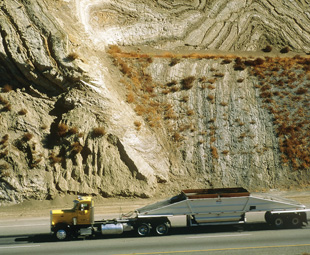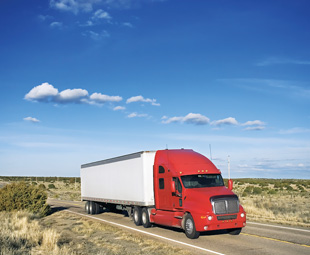The culture of big

The Americas: two continents that share a name but couldn’t be more different. GAVIN MYERS looks at some factors that make trucking on these continents unique, yet surprisingly similar
It’s as American as baseball and Pamela Anderson. In the land of the free, everything is upsized, supersized and megasized (with no reference to Ms Anderson). Bigger is better. The distances are longer, the cargo heavier, the trucks bigger. Ten-four, Jim. Now add the second America, and you can see that we’re talking big, really big.
The allure of trucking in America could have something to do with the old industry adage “If you bought it, a truck brought it.” As early as 1940, movies about trucking were hitting the box office. They Drive by Night starred Humphrey Bogart as one of the Fabrini brothers; embattled independent truck drivers trying to make a success of their transport company following the Great Depression.
Maybe you caught Duel – Steven Spielberg’s debut film back in 1972, in which an anonymous tanker driver terrorises a salesman driving cross-country with his rusty old 1955 Peterbilt 281. Spielberg chose this truck specifically and directed the shots in such a way to make it seem “alive” in its “attack” on the salesman. Five years later came a classic called Smokey and the Bandit. More recently, the 2001 film Joy Ride tells the story of three American youngsters who play a prank on a trucker they come across on CB (Citizen Band) radio, who then sets out for revenge. It goes on. Then there are the magnificent trucks that star in the Transformers movies.
According to the 2011 National Transportation Statistics report – published by the Bureau of Transportation Statistics, a unit in the US Department of Transportation’s Research and Innovative Technology Administration – there were 6 061 000 trucks in fleets across the US in 2009; 5 012 000 were produced in the country in 2010 (the figure for passenger cars was 2 731 000). In 2008, truck combinations covered a total of 183 826 million miles (294 121 million km).
In the decade between 1993 and 2002, the value of trucking increased from $4,7 trillion to $6,7 trillion. Trucks moved about 58 percent of the total freight tonnage, up from 54 percent in 1993, while truck tonne-miles grew by 56 percent. A decade earlier, trucks moved about 26 percent of tonne-miles, rail about 27 percent, water about 24 percent and pipeline about 16 percent.
 Each year, the American trucking industry directly contributes five percent to the country’s gross domestic product (GDP). It is said to employ over 10 million people, the majority of drivers aged between 35 and 54. Interestingly, the American Bureau of Labour Statistics states that truck drivers account for the highest number of all work-related deaths. Truck drivers are five times more likely to die on the job than the average worker – due largely to their relatively unhealthy lifestyle.
Each year, the American trucking industry directly contributes five percent to the country’s gross domestic product (GDP). It is said to employ over 10 million people, the majority of drivers aged between 35 and 54. Interestingly, the American Bureau of Labour Statistics states that truck drivers account for the highest number of all work-related deaths. Truck drivers are five times more likely to die on the job than the average worker – due largely to their relatively unhealthy lifestyle.
The continued importance of the trucking industry in America is further emphasised by the fact that by 1920 there were already over a million trucks travelling America’s roads. The 1940s and 1950s saw a boost to the road network when, between presidents Roosevelt and Eisenhower, the inception and construction of the country’s famed Interstate Highway System was actioned.
Connecting each of the 48 states on the mainland, the 75 440-total-kilometre-long Interstate system took 35 years to complete. In the initial years, the trucking industry boomed as a direct result of it.
Lots of big numbers here, and they’re about to get bigger.
Together, the Americas have a population of around 900 million; just under 530 million people in the north and around 370 million in the south.
Despite differing in almost every way – one a fully-advanced first-world country, the other still largely undeveloped – these two vast continents are served by some of the most comprehensive freeway networks and passionate trucking industries in the world. In this respect, they almost become one big united nation. And the bigger the area, the bigger the challenges.
The Pan-American Highway is a mega highway. Stretching from Ushuaia in Argentina, it passes through another 22 countries before linking up with the US Interstate on the Mexican border at Laredo in Texas and proceeding all the way up to Prudhoe Bay in Alaska – almost literally linking the top and bottom tips of the Americas.
This highway is almost 48 000 km long. Take a moment to think about that. It passes through many diverse climates and ecologies, from dense jungles to arid deserts and cold mountain passes. Some parts are only passable in the dry season.
A range of challenges is naturally posed to hauliers running cross-border operations within, through and between southern, middle and northern America.
Brazil, for example, has close to 1,8 million km of roads, but only 96 353 km of these roads are paved. That’s five-and-a-half percent. On the upside, investment in South American countries is high and many are making substantial infrastructure upgrades.
Compounding the challenges of geography is the fact that most countries the Pan-American Highway passes through have their own road systems, their own sets of road laws and their own vehicle regulations. In the US, it’s the Federal Motor Carrier Safety Administration (FMCSA), which falls under the US Department of Transport, that is responsible for regulation of almost all aspects of the country’s trucking industry. Operators just have the requirements of the remaining 23 countries to get to grips with, and they’re good to go.
And we thought Africa wasn’t for sissies. Ten-four, Jim!
Published by
Focus on Transport
focusmagsa



